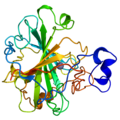Carbonic anhydrase
Carbonic anhydrase is a family of enzymes that catalyze the rapid interconversion of carbon dioxide and water to bicarbonate and protons (or vice versa), a reaction that occurs rather slowly in the absence of a catalyst.
Function[edit]
Carbonic anhydrase helps regulate pH and fluid balance in various parts of the body. It is found in a variety of tissues, including red blood cells, the kidneys, and the eyes. In the kidney, it helps reabsorb bicarbonate, a key component of the blood buffer system. In the eye, it helps produce aqueous humor, the fluid that fills the anterior chamber of the eye.
Types[edit]
There are several types of carbonic anhydrase, which are classified based on their structural characteristics. These include:
- Carbonic anhydrase I (CA I), which is found primarily in red blood cells.
- Carbonic anhydrase II (CA II), which is found in many tissues, including the kidneys and the eyes.
- Carbonic anhydrase III (CA III), which is found in skeletal muscle.
- Carbonic anhydrase IV (CA IV), which is found on the surface of endothelial cells in the lungs and kidneys.
Clinical significance[edit]
Mutations in the genes that encode carbonic anhydrase can lead to a variety of disorders. For example, mutations in the gene for CA II can cause osteopetrosis (a condition characterized by dense, brittle bones), renal tubular acidosis (a condition characterized by acidic blood), and cerebral calcification (a condition characterized by calcium deposits in the brain).
Inhibitors of carbonic anhydrase, such as acetazolamide, are used to treat conditions such as glaucoma, epilepsy, and altitude sickness.
See also[edit]
References[edit]
<references />
|
|
|
-
Human carbonic anhydrase II structure
-
Mechanism of carbonic anhydrase II
-
Active site of carbonic anhydrase II
-
Active site of carbonic anhydrase 1CA2
-
Carbonic anhydrase II enzyme
-
Structure of carbonic anhydrase 1CA2
-
Ligands and pocket style of carbonic anhydrase
Ad. Transform your life with W8MD's Budget GLP-1 injections from $75


W8MD offers a medical weight loss program to lose weight in Philadelphia. Our physician-supervised medical weight loss provides:
- Weight loss injections in NYC (generic and brand names):
- Zepbound / Mounjaro, Wegovy / Ozempic, Saxenda
- Most insurances accepted or discounted self-pay rates. We will obtain insurance prior authorizations if needed.
- Generic GLP1 weight loss injections from $75 for the starting dose.
- Also offer prescription weight loss medications including Phentermine, Qsymia, Diethylpropion, Contrave etc.
NYC weight loss doctor appointmentsNYC weight loss doctor appointments
Start your NYC weight loss journey today at our NYC medical weight loss and Philadelphia medical weight loss clinics.
- Call 718-946-5500 to lose weight in NYC or for medical weight loss in Philadelphia 215-676-2334.
- Tags:NYC medical weight loss, Philadelphia lose weight Zepbound NYC, Budget GLP1 weight loss injections, Wegovy Philadelphia, Wegovy NYC, Philadelphia medical weight loss, Brookly weight loss and Wegovy NYC
|
WikiMD's Wellness Encyclopedia |
| Let Food Be Thy Medicine Medicine Thy Food - Hippocrates |
Medical Disclaimer: WikiMD is not a substitute for professional medical advice. The information on WikiMD is provided as an information resource only, may be incorrect, outdated or misleading, and is not to be used or relied on for any diagnostic or treatment purposes. Please consult your health care provider before making any healthcare decisions or for guidance about a specific medical condition. WikiMD expressly disclaims responsibility, and shall have no liability, for any damages, loss, injury, or liability whatsoever suffered as a result of your reliance on the information contained in this site. By visiting this site you agree to the foregoing terms and conditions, which may from time to time be changed or supplemented by WikiMD. If you do not agree to the foregoing terms and conditions, you should not enter or use this site. See full disclaimer.
Credits:Most images are courtesy of Wikimedia commons, and templates, categories Wikipedia, licensed under CC BY SA or similar.
Translate this page: - East Asian
中文,
日本,
한국어,
South Asian
हिन्दी,
தமிழ்,
తెలుగు,
Urdu,
ಕನ್ನಡ,
Southeast Asian
Indonesian,
Vietnamese,
Thai,
မြန်မာဘာသာ,
বাংলা
European
español,
Deutsch,
français,
Greek,
português do Brasil,
polski,
română,
русский,
Nederlands,
norsk,
svenska,
suomi,
Italian
Middle Eastern & African
عربى,
Turkish,
Persian,
Hebrew,
Afrikaans,
isiZulu,
Kiswahili,
Other
Bulgarian,
Hungarian,
Czech,
Swedish,
മലയാളം,
मराठी,
ਪੰਜਾਬੀ,
ગુજરાતી,
Portuguese,
Ukrainian









